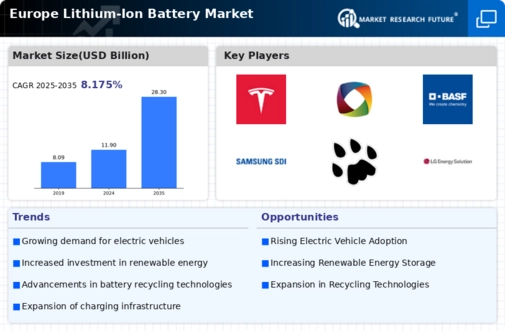The European Lithium-Ion Battery Market has become increasingly competitive as various companies strive to capture a share of the growing demand for energy storage solutions, primarily driven by the electrification of transportation and renewable energy adoption. The market has experienced significant growth, fueled by advancements in technology, manufacturing capabilities, and environmental policies promoting sustainable energy sources. Key players in this space are constantly innovating and investing in research and development to enhance battery performance, reduce costs, and increase production capacities.
Competitive strategies such as strategic partnerships, geographic expansion, and mergers and acquisitions are prevalent as companies seek to strengthen their market positions and respond to evolving consumer preferences.
In the context of the Europe Lithium-Ion Battery Market, Tesla stands out as a formidable competitor with a strong market presence. The company's commitment to sustainability and innovation resonates well in Europe, where consumers and governments alike prioritize environmental concerns. Tesla's strength lies in its advanced battery technology, which provides longer range and efficiency compared to many competitors. The company's established brand reputation and the success of its electric vehicles contribute to increased demand for its battery solutions in the region.
Furthermore, Tesla’s extensive Supercharger network enhances the attractiveness of their vehicles, thereby indirectly promoting their battery technology. The company continues to focus on expanding its manufacturing footprint in Europe, aiming to streamline production and reduce logistics costs, which positions Tesla favorably in this competitive landscape.BYD also plays a crucial role in the European Lithium-Ion Battery Market, leveraging its comprehensive portfolio of products, including electric vehicles, batteries, and energy storage systems.
The company has made significant inroads into the European market by supplying electric buses and other vehicles, simultaneously establishing itself as a reliable battery supplier in the region. BYD's strengths lie in its vertically integrated supply chain and innovative battery technologies, which enable cost-effective production and high-quality products. In recent years, BYD has engaged in strategic partnerships and joint ventures aimed at enhancing its footprint in Europe, capitalizing on rising demand for sustainable transportation solutions.
The company's ongoing investments in expanding production capacity and collaboration with local entities strengthen its competitiveness in the market, ensuring that BYD remains a key player in the evolving landscape of the European Lithium-Ion Battery Market.





















Leave a Comment